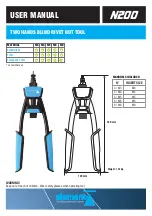
residual current device by contacting your sealey dealer. You must also read and understand the following instructions concerning
electrical safety.
1.3.1. The Electricity At Work Act 1989 requires all portable electrical appliances, if used on business premises, to be tested by a qualified
electrician, using a Portable Appliance Tester (PAT), at least once a year.
1.3.2.
The Health & Safety at Work Act 1974 makes owners of electrical appliances responsible for the safe condition of those appliances
and the safety of the appliance operator. If in any doubt about electrical safety, contact a qualified electrician.
1.3.3.
Ensure that the insulation on all cables and on the appliance is safe before connecting it to the power supply. See 1.3.1 and 1.3.2
and use a Portable Appliance tester.
1.3.4.
Ensure that cables are always protected against short circuit and overload.
1.3.5.
Regularly inspect power supply cables and plugs for wear or damage and check all
connections to ensure none is loose.
1.3.6.
Important: Ensure that the voltage marked on the appliance matches the power supply
to be used and that the plug is fitted with the correct fuse - see fuse rating at right.
1.3.7.
do not
pull or carry the appliance by the power cable.
1.3.8.
do not
pull the plug from the socket by the cable.
1.3.9.
do not
use worn or damage cables, plugs or connectors. immediately have any faulty
item repaired or replaced by a qualified electrician. When an ASTA/BS approved UK 3 pin
plug is damaged, cut the cable just above the plug and dispose of the plug safely.
ensure that the double insulated charger is correctly connected via a three-pin plug, as follows:
a)
Connect the Brown live wire to live terminal ‘L’.
b)
Connect the Blue neutral wire to the neutral terminal ‘N’.
c)
After wiring, check that there are no bare wires, that all wires have been correctly `
connected, that the cable outer insulation extends past the cable clamp and that the clamp is
tight. note that the earth pin ‘e’ remains unconnected.
1.3.10. If an extension reel is used it should be fully unwound before connection. A reel with an RCD fitted is preferred since any appliance
plugged into it will be protected. The cable core section is important and should be at least 1.5mm², but to be absolutely sure that
the capacity of the reel is suitable for this product and for others which may be used in the other output sockets, we recommend the
use of 2.5mm² section cable. If extension reel is to be used outdoors, ensure it is marked for outdoor use.
1.4.
Battery charger safety instructions
Warning!
do not
attempt to charge any battery other than that supplied for the riveter. Other types of batteries may explode!
9
All mains electrical supply safety features must be followed as described in 1.3 above.
9
disconnect the charger from the mains supply when not in use.
8
do not
charge battery if room temperature is below 10°C (50°F) or above 40°C (104°F).
8
do not
expose the charger to damp or wet conditions.
8
do not
pull or carry the charger by the power lead.
8
do not
operate the charger if it has been dropped, or has received a sharp knock, or is damaged. take the charger to an authorised
agent for repair or obtain a replacement.
8
do not
dismantle the charger as this may cause damage and/or personal injury and will invalidate the warranty.
8
do not
insert foreign objects or material into the hole reserved for the battery pack.
8
do not
recharge a second battery pack immediately after charging the first. Consecutive charging will overheat the charger. Allow
the unit to cool for 15 minutes before charging the next pack.
8
do not
attempt to connect two chargers together.
8
Store the charger in the same manner as the battery pack in 1.2.
2. introduction
s
uitable for aluminium, steel and stainless steel rivet nuts from M3 to M10. Powered by a 18V 3Ah lithium-ion battery with a pulling force of up
to 14000N, capable of pulling up to 500 rivets on one full charge. Removing the nut adaptor allows use as an impact driver using the 1/4” quick
release bit holder. Supplied with 6 sets of pulling rods and nuts, 6 HSS bits for drilling pilot holes and 4 sockets with hexagon connections, 1hr
mains charger with BS UK plug. Supplied in carry-case. full charge. Removing the nut adaptor allows use as an impact driver using the 1/4”
quick release bit holder. Supplied with 6 sets of pulling rods and nuts, 6 HSS bits for drilling pilot holes and 4 sockets with hexagon connections,
1hr mains charger with BS UK plug. Supplied in carry-case.
3. specification
model no: ......................................................................cp315
Pulling rods and nut sizes: ..............
M3, M4, M5, M6, M8, M10
drill sizes: ..................................................
6, 7, 8, 9, 11, 13mm
nut driver sizes: .............................................
7, 8, 9, 11, 13mm
Battery type: ......................................................
18V 3Ah Li-ion
m
aximum pulling force:
................................................
14000N
replacement battery: ................................................
CP315BP
Weight: .............................................................................
1.5kg
rivet nut types: .......................Aluminium, steel, stainless steel
4. instructions
4.1.
charging
4.1.1.
Plug the charger into the mains, the indicator will light green.
4.1.2.
insert the battery into the charger the indicator will turn red.
4.1.3.
When the indicator light turns green charging is completed.
4.1.4.
remove battery from the charger and switch off at the mains.
fig.1
c
P315 | Issue 1 09/07/15
Original Language Version
© Jack sealey limited
recommended
fuse rating: 3amp





















